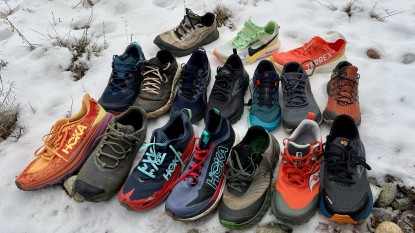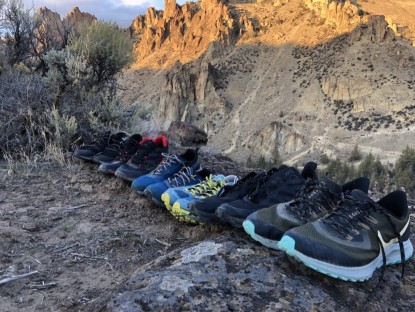Brooks Cascadia 11 Review
Our Verdict
Our Analysis and Test Results
Here at OutdoorGearLab.com we buy all of the products that we test so that we are not beholden to any person or any company to put a shiny spin on a product that we don't like. We also do our best to create comparison reviews, so rather than just testing a product in isolation, we are testing all of the products at the same time and then comparing them to each other. Compared to the 13 other pairs of trail running shoes we tested in 2016, and compared to the previous four versions of the Cascadia line that we have worn and run in, we simply did not like this shoe. For us, it was oppressively uncomfortable.
We took them on an eight-day backpacking and running trip into the Weminuche Wilderness of Southern Colorado, and after experiencing significant rubbing and pain on the tops of our feet due to the construction of the tongue and the general tight fit, we sincerely lamented that we didn't have another pair of shoes to change into for the entire journey. While plenty of people will love this shoe and have no issues with comfort and fit like we did, we are simply going to tell it to you straight in this review.
Foot Protection
The underfoot protection of this shoe is solid, among the best that we tested. The combination of BioMoGo midsole padding with the ballistic rock shield under the forefoot rather than simply the midfoot and arch, makes this a stiff, rigid, and incredibly protective shoe underfoot, which we loved. Nothing has changed about the construction of the midsole or outsole for this version of the Cascadia, and thus those who found the Cascadia 10's to be to their liking, will also like the chassis of this shoe.
The upper is completely redesigned, and while the Cascadia 10's suffered from the severe flaw of tearing wide open at the forefoot crease spot, we did not have that happen with these shoes. However, perusing customer reviews online, we have found some reports of this happening, so buyer beware. In general we fully endorse what Brooks is doing in the midsole and outsole of this shoe, and gave them 9 out of 10 points, the same as the La Sportiva Wildcat and The North Face Ultra Endurance.
Traction
While the outsole remains completely unchanged on this shoe from the pattern used on the Cascadia 10, we found it performs merely average. The lug pattern is very tight, which collects mud and debris more than other shoes, especially in the rear of the foot. Moreover, the tiny lugs that form the edges of the entire sole are prone to ripping off quite easily, and we had that happen with many of them. On dry trail this shoe grips plenty well, and so we graded it 7 out of 10, roughly comparable to the New Balance Leadville v3.
Stability
The shoe features a 10mm heel-toe drop, placing it firmly within the traditional category. However, it is surely the narrowest shoe that we tested in this years review. Many online customer reviews complained that it was narrower than the Cascadia 10, and upon lining them up sole to sole, this is indeed true, these shoes are at least a couple millimeters narrower than their already long and narrow predecessors. The end result of these two facts is that these shoes are merely average when considering stability. Not low and super stable like the Altra Superior 3.5, but not top-heavy and ankle rolling prone like the Salomon Speedcross 4. Simply average.
Comfort
While we considered this to be the least comfortable shoe in the entire review, and the least comfortable version of the Cascadia that we have tested, we still gave them the benefit of the doubt and awarded 5 points. Comfort is subjective, and while these shoes didn't work for our feet at all, others may find them to be basically ideal.
Our biggest complaint had to do with the construction of the tongue on the inside of the upper. The way it is sewed into the front of the shoe, aligned roughly underneath where the laces end at the front of the foot, left a huge overlap of rough edged fabric sitting against the top of the foot. When we would walk or run, thereby flexing the forefoot, the upper would pinch at this exact point and drive this extra rough material into the top of our feet, aligning with the bottoms of our toes. This had the effect of pinching, rubbing, stabbing into the tops of the feet and toe crease in a way that wasn't a nuisance, wasn't annoying, wasn't inconvenient, but was downright painful!
No matter how the shoe, the sock, the laces, the tongue, or the stride and gait of running and walking was adjusted, we couldn't make this pain go away. We seriously considered slicing the shoe apart to get through our eight day backcountry trip, but didn't for the sake getting photos for this review. We cursed these shoes for eight days, and have never in our lives experienced such a discomfort in a pair of $120 shoes. A quick perusal of customer reviews online shows that complaints abound about the comfort and fit of these shoes, with many people complaining about the tongue in particular.
We certainly concede that there are obviously plenty of happy purchasers of the Cascadia 11, but we also want to warn our readers that there is a pretty serious flaw with the design and construction of this shoe, and there are countless other very high quality shoes to consider without these flaws. This is where we direct you to view our Editors' Choice Award Winner, the Nike Terra Kiger 4 as a far superior alternative. Enough said.
Weight
Our pair of Men's size 11 shoes weighed 25.5 ounces straight out of the box. These were among the heaviest of the review, similar to the Asics Gel-FujiTrabuco 4 Neutral. We could only award 5 points for this category, as we think that it is time for high end trail running shoes to be engineered with weight in mind, and many of the top shoes in our review have come in at a much lower weight, with much higher performance.
Sensitivity
The Cascadia 11 is also among the lowest scorers in our review in terms of sensitivity. While the four post pivot points in both the forefoot and the heel do help with the flexibility of the midsole, the hard rock plate limits what is felt of the trail underneath. This shoe is not made for dancing, it is made for walking and running long distances on difficult terrain, so this is really no surprise. It is roughly as un-sensitive as the Hoka Challenger ATR 3.
Best Applications
The Cascadia 11 is designed as a high mileage shoe capable of taking on the long trails and races of the world. It is also very popular as a hiking and backpacking shoe.
Value
This shoe retails for $120, roughly the same as most of the shoes in this review. Considering the discomfort we felt in this shoe, we don't think it is worth that kind of money at all, and instead point our readers to much higher performing shoes for the same price, like the Saucony Peregrine 7 or the Montrail Caldorado, not to mention our award winners. It is worth noting that should you opt for these shoes and have an issue, Brooks will replace them for you if it is within 30 days of the purchase date.
Conclusion
The Brooks Cascadia 11 was unfortunately a disappointing version of this best-selling shoe. While Brooks loves to keep tweaking and changing things year to year, in 2016 they took a step backwards from a shoe that we thought was pretty good the year before. Due to issue with the construction of the tongue, as well as a very narrow and low volume fit, we found these shoes to be very uncomfortable and would not recommend them over the other high quality shoes in this review.












